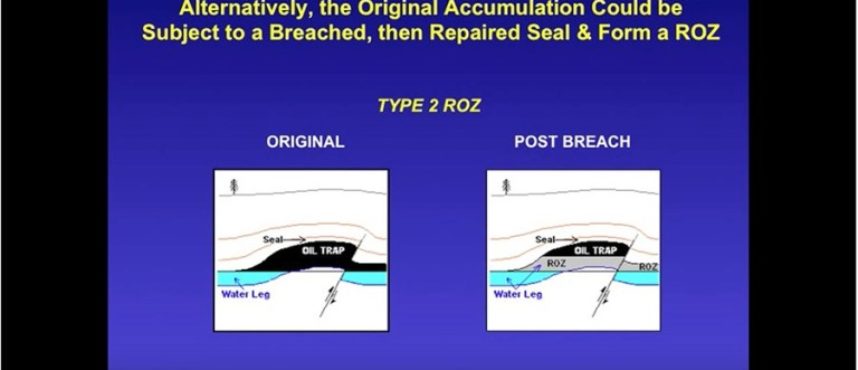Residual Oil Zone Type 2
The oil and gas industry has learned in recent years that oil entrapments may have undergone some changes in their geologic past. It isn’t proper in many basins to think that the original stage of tectonics, which includes: burial, oil generation, and migration into a structurally high trap, might not have been altered by a second or third, or fourth stage where water and oil moved around in the sub-surface. We like to call this mother nature’s water floods, and for the purposes of discussion in this presentation, we’re going to look at four slides and show what we like to call the type two residual oil zone or ROZ type 2. This first slide is a hypothetical trap that might be representative of the original stage of tectonics and the original entrapment. Sometimes, we like to call that the paleo entrapment first stage. This left side here is a type two ROZ, one in which we breach a seal to that trap and move oil out vertically.
But there are two other types as well; one that would be just due to a basin-wide tilt, and this slide here would show that we’ve moved the basin down to the west and moved oil out to the east, and changed the oil-water contact due to that tilt of the basin.
The Second Stage, as I mentioned, is a breached seal, a third type of ROZ is one where we have a hydrodynamic gradient. We will not discuss that today but what that represents is an outcrop perhaps of the reservoir formation somewhere out here to the west on the left side of this slide, and water moves down deep through the basin, tilts the oil-water contact, and moves oil out to the east.
We’ve animated this type two ROZ, and we’ve shown the fault here to make the discussion a little bit easier. Due to pressure, earthquakes, and the paleo history of this reservoir, the oil may leak out vertically; it may find a new reservoir above the former reservoir, and as you see in the animation, it accumulates under a seal up above that and what’s happened is the water has moved into the formerly oil occupied portion of the lower part of that lower trap and moved the oil up and created a horizontal bottom to the residual oil zone and horizontal top which is also the base of the new modern-day oil trap. That’s the target that we go after with enhanced oil recovery. When the oil saturation is sufficient, we can get that economically in today’s methods of EOR.
Contact Melzer Consulting at (432) 682-7664 or fill out our contact form for more information.

